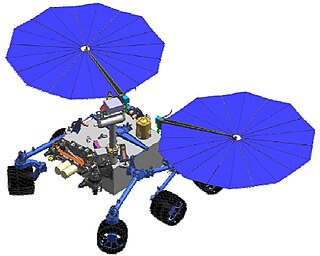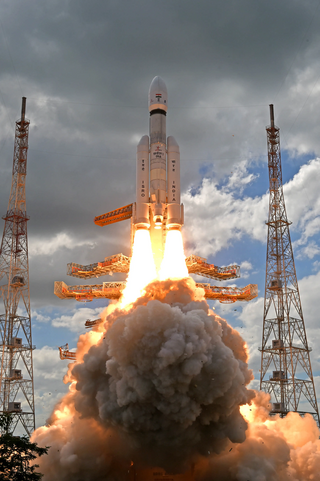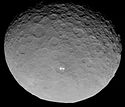
Phobos is the innermost and larger of the two natural satellites of Mars, the other being Deimos. The two moons were discovered in 1877 by American astronomer Asaph Hall. It is named after Phobos, the Greek god of fear and panic, who is the son of Ares (Mars) and twin brother of Deimos.

A lander is a spacecraft that descends towards, then comes to rest on the surface of an astronomical body other than Earth. In contrast to an impact probe, which makes a hard landing that damages or destroys the probe upon reaching the surface, a lander makes a soft landing after which the probe remains functional.

The Beagle 2 is an inoperative British Mars lander that was transported by the European Space Agency's 2003 Mars Express mission. It was intended to conduct an astrobiology mission that would have looked for evidence of past life on Mars.

A Mars rover is a remote-controlled motor vehicle designed to travel on the surface of Mars. Rovers have several advantages over stationary landers: they examine more territory, they can be directed to interesting features, they can place themselves in sunny positions to weather winter months, and they can advance the knowledge of how to perform very remote robotic vehicle control. They serve a different purpose than orbital spacecraft like Mars Reconnaissance Orbiter. A more recent development is the Mars helicopter.

A Mars sample-return (MSR) mission is a proposed mission to collect rock and dust samples on Mars and return them to Earth. Such a mission would allow more extensive analysis than that allowed by onboard sensors.

Ceres, minor-planet designation 1 Ceres, is a dwarf planet in the middle main asteroid belt between the orbits of Mars and Jupiter. It was the first asteroid discovered on 1 January 1801, by Giuseppe Piazzi at Palermo Astronomical Observatory in Sicily and announced as a new planet. Ceres was later classified as an asteroid and then a dwarf planet, the only one always inside Neptune's orbit.

The Mars Astrobiology Explorer-Cacher (MAX-C), also known as Mars 2018 mission, was a NASA concept for a Mars rover mission, proposed to be launched in 2018 together with the European ExoMars rover. The MAX-C rover concept was cancelled in April 2011 due to budget cuts.

Mars Exploration Program (MEP) is a long-term effort to explore the planet Mars, funded and led by NASA. Formed in 1993, MEP has made use of orbital spacecraft, landers, and Mars rovers to explore the possibilities of life on Mars, as well as the planet's climate and natural resources. The program is managed by NASA's Science Mission Directorate by Doug McCuistion of the Planetary Science Division. As a result of 40% cuts to NASA's budget for fiscal year 2013, the Mars Program Planning Group (MPPG) was formed to help reformulate the MEP, bringing together leaders of NASA's technology, science, human operations, and science missions.
Hayabusa Mk2 was a proposed Japan Aerospace Exploration Agency (JAXA) space mission aimed at visiting a small primitive asteroid and returning a sample to Earth for laboratory analysis. It was intended to be the follow-on mission to JAXA's Hayabusa mission, as well as the Hayabusa2 mission. The latest proposal for Hayabusa Mk2 stated its target to be the dormant comet 4015 Wilson–Harrington, with a launch of the probe in 2018. From 2007 to 2010, it was also considered as a joint JAXA-ESA mission under the name Marco Polo. The in-situ investigation and sample analysis would allow scientists to improve our knowledge of the physical and chemical properties of a small Near-Earth Object (NEO) which is thought to have kept the original composition of the solar nebula in which planet formed. Thus, it would provide some constraints to the models of planet formation and some information on how life may have been brought to Earth. Information on the physical structure will help defining efficient mitigation strategies against a potential threatening object.
The Asteroid Impact and Deflection Assessment (AIDA) missions are a proposed pair of space probes which will study and demonstrate the kinetic effects of crashing an impactor spacecraft into an asteroid moon. The mission is intended to test and validate impact models of whether a spacecraft could successfully deflect an asteroid on a collision course with Earth.

Mars 2020 is a Mars rover mission that includes the rover Perseverance, the small robotic helicopter Ingenuity, and associated delivery systems, as part of NASA's Mars Exploration Program. Mars 2020 was launched from Earth on an Atlas V launch vehicle at 11:50:01 UTC on 30 July 2020, and confirmation of touch down in the Martian crater Jezero was received at 20:55 UTC on 18 February 2021. On 5 March 2021, NASA named the landing site of the rover Octavia E. Butler Landing. As of 17 December 2023, Perseverance and Ingenuity have been on Mars for 1005 sols.

The Chandrayaan programme also known as the Indian Lunar Exploration Programme is an ongoing series of outer space missions by the Indian Space Research Organization (ISRO) for the exploration of the Moon. The program incorporates a lunar orbiter, an impactor, a soft lander and a rover spacecraft.

Several bright surface features were discovered on the dwarf planet Ceres by the Dawn spacecraft in 2015.
Phootprint is a proposed sample-return mission to the Mars moon Phobos by the European Space Agency (ESA), proposed to be launched in 2024.

The NASA-ESA Mars Sample Return is a proposed Flagship-class Mars sample return (MSR) mission to collect Martian rock and soil samples in 43 small, cylindrical, pencil-sized, titanium tubes and return them to Earth around 2033.














